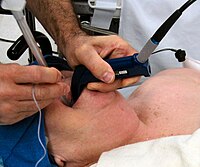
Photo from wikipedia
Purpose: The bronchoscopy suite is where pulmonologists perform the majority of their procedures like bronchoscopy, endobronchial ultrasound, and navigational bronchoscopy among others. Faculty and fellows in our division have reported… Click to show full abstract
Purpose: The bronchoscopy suite is where pulmonologists perform the majority of their procedures like bronchoscopy, endobronchial ultrasound, and navigational bronchoscopy among others. Faculty and fellows in our division have reported multiple delays in the procedure start time in our bronchoscopy. Objectives: Objectives of the study were (1) to identify the areas of delays in procedure start time, (2) to identify potential high-yield areas of interventions to reduce delays, (3) to assess the impact of interventions on efficacy of bronchoscopy suit. Methods: We have conducted a quality improvement project aiming at identifying areas of delays and implemented an intervention aiming at minimizing those delays. We retrospectively collected the data about the patient flow from arrival to hospital to discharge between June and August 2016. We used fishbone technique to identify the potential reasons for delay in procedures and to identify low-effort high-yield areas. Our intervention was raising awareness and education among the personnel and designing the process to reduce time delays and improve efficacy. We collected the data about the patient flow prospectively after the invention was implemented. Results: The study showed that 76.4% of our preintervention procedures had a late start time. The postintervention results revealed a statistically significant reduction in the procedure late start times by 24.4% (P = .02). Signing the procedure H and P was also identified as a major area of delay, which has improved postintervention (65.5 % vs 33.3%, P = 0.017). Conclusion: The faculty and fellows' perceptions were translated into objective data, which serves as a first step in our division to improve the patient flow process in the bronchoscopy suite. Areas of delays were identified and our intervention resulted in significant improvement, but more work needs to be done to achieve a more efficient patient flow in the bronchoscopy suite while maintaining a safe patient care.
Journal Title: Quality Management in Health Care
Year Published: 2018
Link to full text (if available)
Share on Social Media: Sign Up to like & get
recommendations!